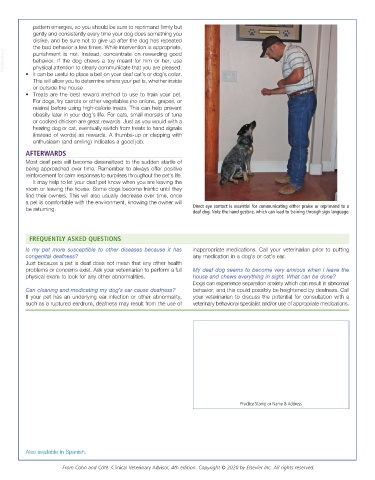Page 3182 - Cote clinical veterinary advisor dogs and cats 4th
P. 3182
pattern emerges, so you should be sure to reprimand firmly but
gently and consistently every time your dog does something you
dislike, and be sure not to give up after the dog has repeated
the bad behavior a few times. While intervention is appropriate,
VetBooks.ir behavior. If the dog chews a toy meant for him or her, use
punishment is not. Instead, concentrate on rewarding good
physical attention to clearly communicate that you are pleased.
• It can be useful to place a bell on your deaf cat’s or dog’s collar.
This will allow you to determine where your pet is, whether inside
or outside the house.
• Treats are the best reward method to use to train your pet.
For dogs, try carrots or other vegetables (no onions, grapes, or
raisins) before using high-calorie treats. This can help prevent
obesity later in your dog’s life. For cats, small morsels of tuna
or cooked chicken are great rewards. Just as you would with a
hearing dog or cat, eventually switch from treats to hand signals
(instead of words) as rewards. A thumbs-up or clapping with
enthusiasm (and smiling) indicates a good job.
AFTERWARDS
Most deaf pets will become desensitized to the sudden startle of
being approached over time. Remember to always offer positive
reinforcement for calm responses to surprises throughout the pet’s life.
It may help to let your deaf pet know when you are leaving the
room or leaving the house. Some dogs become frantic until they
find their owners. This will also usually decrease over time, once
a pet is comfortable with the environment, knowing the owner will
be returning. Direct eye contact is essential for communicating either praise or reprimand to a
deaf dog. Note the hand gesture, which can lead to training through sign language.
FREQUENTLY ASKED QUESTIONS
Is my pet more susceptible to other diseases because it has inappropriate medications. Call your veterinarian prior to putting
congenital deafness? any medication in a dog’s or cat’s ear.
Just because a pet is deaf does not mean that any other health
problems or concerns exist. Ask your veterinarian to perform a full My deaf dog seems to become very anxious when I leave the
physical exam to look for any other abnormalities. house and chews everything in sight. What can be done?
Dogs can experience separation anxiety which can result in abnormal
Can cleaning and medicating my dog’s ear cause deafness? behavior, and this could possibly be heightened by deafness. Call
If your pet has an underlying ear infection or other abnormality, your veterinarian to discuss the potential for consultation with a
such as a ruptured eardrum, deafness may result from the use of veterinary behavioral specialist and/or use of appropriate medications.
Practice Stamp or Name & Address
Also available in Spanish.
From Cohn and Côté: Clinical Veterinary Advisor, 4th edition. Copyright © 2020 by Elsevier Inc. All rights reserved.

